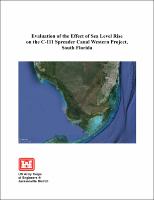Please use this identifier to cite or link to this item:
https://hdl.handle.net/11681/44042| Title: | Evaluation of the Effect of Sea Level Rise on the C-111 Spreader Canal Western Project, South Florida |
| Authors: | Landers, Glenn B. Shafer, Mark Pinson, Ariane O. |
| Keywords: | Sea level Restoration ecology Wetlands Canals Everglades (Fla.) |
| Publisher: | United States. Army. Corps of Engineers. Jacksonville District. |
| Abstract: | For the next 100 years and beyond, sea level rise is anticipated to pose widespread and continuing threats to both the natural and built environments, and to the regional economy of the Southeastern U.S. (NCA report). Because of its low relief and low elevation, South Florida, including the Cities of Miami, Miami Beach, and Homestead, is at particular risk even from modest increases in sea level and/or storm surges. Much of south-central and southwestern Florida consists of freshwater sawgrass wetlands and, along the coast, brackish-water mangrove ecosystems. Much of the region is protected as Everglades National Park (ENP), Big Cypress National Preserve, and smaller state parks; managed as wetlands (such as Water Conservation Areas (WCA) 1-3); or farmed to provide food for people (Everglades Agricultural Area (EAA)). Historically, the natural ecosystems were sustained by surface and near-surface flows originating in Lake Okeechobee, flowing south through the EAA and WCAs into ENP, where much of the water then flowed southwest through Shark River and Taylor Sloughs to Florida Bay (Figure 1). Diversion of a large share of this flow has resulted in significant degradation of the greater Everglades ecosystem. WRDA 2000 authorized the Comprehensive Everglades Restoration Plan (CERP), and the plan includes restoration of sufficient surface water to sustain these unique south Florida ecosystems. The C-111 Spreader Canal Western Project is a U.S. Army Corps of Engineers (USACE) subproject under the CERP umbrella. The goal of this project is to restore wetland conservation areas near and inside the eastern boundary of Everglades National Park which have been impacted by past construction and operation of the adjacent C-111 Canal. The C-111 Canal is located southwest of the City of Homestead at an elevation less than 6 feet above current sea level, which means that sea level rise could impact the project during its 50-year lifetime. Consequently, the USACE Institute for Water Resources Responses to Climate Change Program funded a study by the Jacksonville District (SAJ) to document how the project delivery team investigated the potential future impact of sea level rise on the C-111 Spreader Canal Western Project features and the restored flows to ENP these features will provide. |
| Description: | Technical Report |
| Rights: | Approved for Public Release; Distribution is Unlimited |
| URI: | https://hdl.handle.net/11681/44042 |
| Appears in Collections: | Technical Report |
Files in This Item:
| File | Description | Size | Format | |
|---|---|---|---|---|
| Sea Level Rise - C-111 Project - 2015.pdf | 1.72 MB | Adobe PDF |  View/Open |